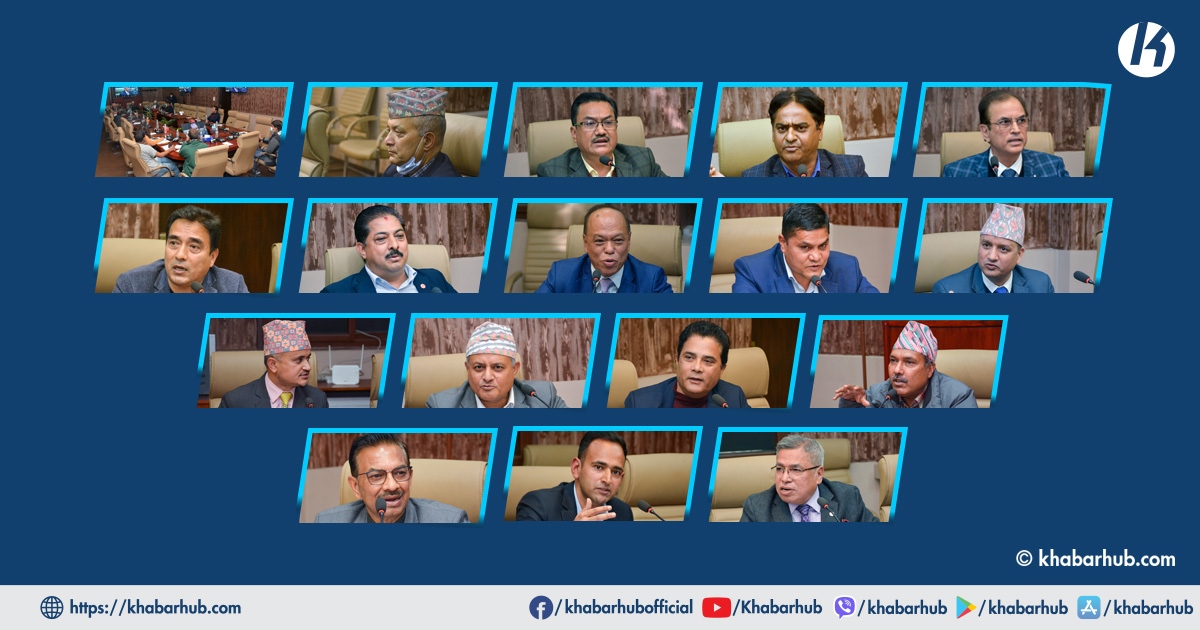KATHMANDU: Experts, stakeholders, businessmen, and bankers have suggested finding out the short-term, mid-term, and long-term solutions for the liquidity crisis in Nepal’s banks and financial institutions.
Taking part in an interaction program ‘Nepal’s Liquidity Crisis and the Way Forward’ organized by the Institute for Strategic and Socio-Economic Research (ISSR) at Pavilion Hall in Kathmandu, Monday, the speakers shed light on various aspects impacting the current liquidity crisis, the economy is facing.
Min Man Shrestha, Chairperson at Urban Development Committee of Federations of Nepalese Chamber of Commerce and Industry (FNCCI), said that Nepal has faced a liquidity crisis due to a lack of coordination between Nepal Rastra Bank, Banks, and government. Stating that Nepal’s economy has never seen such a severe liquidity crisis, Shrestha reiterated that the bank should not give interest rates to the institutional depositors. “All concerned authorities should focus on short-term as well as long-term plans,” he added.

Shrestha pointed out that despite the government policy to allow foreign nationals to buy and sell apartments, billions of dollars can be brought into Nepal every year.
He asserted that many foreigners want to come to Nepal and stay in Nepal in their retired life. The cost of living is very low in Nepal compared to the western countries and live luxurious life through their pension. If we can go through this process, it helps to grow Nepal’s economy.
Likewise, Naresh Shrestha, Director at ISSR, remarked that it was time to be vigilant to address the future economic crisis due to the lack of liquidity in Nepal. He said that the concerned bodies should be interested in resolving the issue. He also questioned why the central bank is auctioning treasury bills when the government’s spending is low to non-existent.

Dr. Ravindra Prasad Pandey, Director at ISSR, highlighted that the economy is not functioning well despite the increase in business in Banks and Financial Institutions (BFIs). He emphasized that the country’s banks and financial institutions are now short on loanable cash and that the private sector is experiencing difficulties obtaining credit.
Further, he said that the country will not develop unless the employment is created inside the country and youths are discouraged from fleeing abroad. He attributed the decline in liquidity to the economy as imports outweighed exports. He stated that, in the first quarter of the current Fiscal Year, exports increased by 109.5 percent to Rs. 65.05 billion and imports increased by 63.7 percent to Rs. 478.52 billion.
As a result, the trade deficit increased by 58.3 percent to Rs. 413.47 billion during the review period. He emphasized that the country’s imports have increased at an exponential rate while its remittance has decreased.
Here are the excerpts of the participants of the program:
Dr. Tara Prasad Pokharel, Vice-President, Cement Manufacturers’ Association
There was an ample amount of lending money in Nepali Banks and Financial institutions (BFIs) till April-June. But, now BFIs have faced a liquidity crush and are unable to lend a minimum of Rs 10 million to their customers.

Concerned bodies should monitor and find out the situations how the BFIs have faced the liquidity crunch.
Development work has been operating in the country but the government has not paid the contractors. Had the government paid up the amount, the problems would have been resolved somehow.
The liquidity crisis is due to a problem in the internal system. The country has become self-reliant in cement and electricity and has to be self-reliant in other sectors as well.
BFIs have been changing the premium amount every three months. Instability in interest amounts has led to the closure of the Industries.
The country can develop only after the establishment of industries, and the government must be responsible to come up with relevant policies and on-time implementation.
Naresh Lal Shrestha, Executive Member, Federation of Nepalese Chambers of Commerce and Industry (FNCCI)
The business sector is in trouble as banks have not been able to give even loans that BFIs have committed to the customers. Yet, BFIs have been increasing interest rates.

The country has faced a deficit trade as import is higher than exports. Due to this, Nepal has faced a liquidity crisis.
If the import rate goes higher than this, the economy of the country will collapse. The disappearance of money from the market has created a crisis.
Ambika Prasad Poudel, President, Capital Market Forum
The current situation has been created due to the lack of coordination among the internal government organizations.

We are facing this situation now as the Ministry of Finance is merely focused on an increment of revenue. After the Post-COVID situation, the share market has given energy to the economy. However, there is a need for further reforms in the capital market.
Anjan Shrestha, Vice President (Commodity), Federation of Nepalese Chambers of Commerce and Industry
It is unclear when the economy of Nepal will go in a balanced line and who will find the way forward to take the surplus economy. There is policy-level corruption in Nepal. Unfortunately, political parties and government employees did not pay attention to the policy method and system.
Nepal has been facing a liquidity crisis after Dashain simultaneously, for the last few years.
Similarly, Nepal is graduating to the status of a middle-income developing nation from the category of a least developed country (LDC) by 2026.
It is said that the Government of Nepal has completed strategic efforts for graduation.

This is an opportunity for the country to raise its image in the international forum by creating structures for its economy within the next five years. But, the problems, like the liquidity crisis, we are facing now may affect the graduation process.
Nepal had met the criteria for its graduation between 2015 and 2018. However, it had been affected and postponed citing that its economy was threatened due to the 2015 earthquake.
Nepal was incorporated into the list of LDCs in 1971.
Although the recent data shows an increase in exports, it is actually due to the increase in the logistic cost of exports.
Rohit Gupta, Vice President, Confederation of Nepalese Industries
The credit deposit (CD) rate has to be increased from 80 percent to 90 percent. Recently, around Rs 100 billion seems to have disappeared from the system.

It has become necessary to find out how it disappeared. Similarly, a liquidity crisis needs to be controlled and a solution has to be found out.
Kiran Kumar Shrestha, CEO, Rastriya Banijya Bank
Banks had estimated that this year’s deposit would be the same as last year. Unfortunately, BFIs could not receive the deposit similar to the last year. This is one reason for the liquidity crisis.

Government lacks to make expenditures due to cumbersome processes. It seems that remittances have to be brought through a complete banking process.
A liquidity crisis can be solved if 40 percent of the people who are not in the banking process are connected with the banks.
Shova Kanta Poudel, Director General, Inland Revenue Department
The rules, regulations, and policies that the government has formulated are relevant. Unless the institutions are reformed, the problem will remain the same as it is now.

100 people in Nepal have contributed more than 60 percent of the revenue. We have termed our economy as a socialist economy, but the control of Nepal’s economy is in the hands of very few people.
Nepal will never be prosperous unless the attitude of Nepali changes. Similarly, the capital market needs to be regulated as well.
Out of 4 million service recipients of the share market, 2 million people are incurring daily losses.
Kamlesh Kumar Agrawal, Senior Vice President, Nepal Chamber of Commerce
Nepal still needs 20 to 25 percent refinancing for the mobility of the economy.

There is a need to improve the monetary policy issued by the NRB recently. Similarly, if the liquidity crisis goes for the long term, Nepal’s currency will be depreciated and may become the worst-performing currency in Asia.
Dr. Gunakar Bhatt, Executive Director, Nepal Rastra Bank
Lately, loan expansion seems to have increased by Rs 0.9 trillion. Similarly, credit has been extended by 12 trillion rupees in 15 months (end of FY 2020/21).
Similarly, the outstanding debt stood at Rs 4.4 trillion. Imports in the last four months stood at Rs 650 billion. Comparing imports and exports puts Nepal’s economy in an alarming position. Three years ago, the lending rate was 12.5 percent. At present, the rate has come down to 8.5 percent.

When the remittances in-flow decrease, foreign investment, and government debt decreases, and foreign investment in the private sector reduces then interest rates are likely to go up.
We need to study how low-interest rates can work in Nepal’s current economy. This is also a matter of concern. We have to find a way out for a fixed interest rate rather than a low-interest rate.
A year and a half years before the COVID-19, fixed interest rates were applied in Nepal. At present, Nepal Rastra Bank has issued 200 billion to manage the liquidity crisis. Out of this, 110 billion is used for refinancing billion and Rs 90 billion for accelerating the economy. Along with this, the accumulated amount and payments have been going into deficit lately. This is also a terrible situation.
The United States also has an inflation rate of 6.2 percent. As a result, the world economy is going beyond expectations. It has also been said that we are looking for an economic solution for the non-economic problems.
For some time now, Nepal’s economy looks very challenging.

The Nepse index had recently reached 3200 points, after which there has been a liquidity crisis in Nepal. In 2015, Nepse had reached from 900 to 1800 points. Two years after that, there was a lack of liquidity in Nepal.
Looking at the latest statistics, Nepse has increased by 135 percent.
In the last 15 months, Nepal has imported vehicles worth Rs 200 billion. We need to think holistically about this situation. To solve this problem, it is necessary to increase the capital expenditure of the government and also bring in foreign investment.
Similarly, external debt also needs to be expanded. When the banking sector issues dividends, this problem may be solved somehow. If the BFIs issue a 25 percent debenture with priority, the problem of liquidity crisis will be minimized. If the business sector continues to issue commercial papers and bonds, that can be a solution.
Mukunda Subedi, Deputy General Manager, NCC Bank
Lately, deposits in Nepal’s banks have been declining day by day. Institutional deposits in banks are 40 percent.
Even institutions have deposited for interest, if this deposit is added then the problem might go worse.

Contradictory to their commitments, banks have not been able to lend Rs 150 billion. This problem is due to the fact that banks lend more in the first five months of the fiscal year whereas the government does not spend in the first five months.
Anil Kumar Upadhyay, President, Nepal Bankers Association
The liquidity problem is often interpreted wrong. It seems the government only collects revenue but does not spend it.

Although the liquidity problem has appeared every year for the last 10 years, no solution has been found for it.
We do not discuss any problem on a short-term, medium-term, or long-term basis.
Dr. Jitendra Upadhyaya, Associate Professor, TU
The current lack of liquidity is due to trade deficit, inflation, and institutional depositors.

Similarly, monetary liquidity can be reduced by taking to goods and products instead of petroleum products. Nepal is currently wasting 400 MW of electricity. When we are able to consume more electricity, the problem will be solved to a large extent. This problem can be solved by issuing debentures.
Krishna Prasad Dahal, President, Finance Committee
The current liquidity crisis in the market is still solvable. This problem has resulted due to the standstill of the tourism sector, foreign investment, and foreign loans.

It seems that investment should be made only in that area that remittance can contribute. There is a need to look for overall growth rather than just looking at only one sector. At present, there is a problem due to policy corruption.









Comment